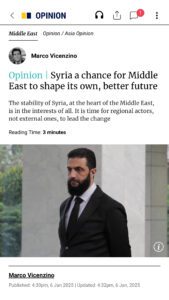Opinion: Syria, Mideast’s Chance to Shape Own Future

OPINION in South China Morning Post
by Marco Vicenzino, 7 January 2025
There are decades when nothing happens and there are weeks when decades happen. This is the Middle East today. The downfall of Syria’s Assad regime, coupled with forces unleashed after Hamas attacked Israel in 2023, have triggered a regional power vacuum.
This crisis of uncertainty presents a historic opportunity for a geopolitical reconfiguration. In recent decades, the Middle East has experienced too many failed resets. It is time to alter course, reverse the cycle and for regional actors – not external players – to lead in shaping change.
Syria’s strategic geography gives it enormous leverage. It is a linchpin for regional security as it lies in the heart of the Middle East and borders several countries. All responsible states have a vested interest in Syria’s stability. Within this momentous context, the first foreign visit by a delegation of Syria’s transitional government to Saudi Arabia marked a major political breakthrough.
Both sides are driven by pragmatism and political reality, not ideological affinity. The kingdom’s historic enmity with Islamist movements has not ceased. But the Saudis accept that the government led by Hayat Tahrir al-Sham (HTS) holds power and must deal with it to exert influence in Syria.
The objective is to prevent a proliferation of threats and spillover into Saudi Arabia and beyond. With its vast resources, the Saudis can play an indispensable role in Syria’s future, in particular replacing Iran as Syria’s chief energy supplier.
After nearly 14 years of war, economic mismanagement and sanctions, Syria desperately needs greater diplomatic recognition to lift the Assad-era sanctions. HTS also needs to be removed from terrorism lists. This would unleash critical international financial aid.
A week ago, the Gulf Cooperation Council called for a reconsideration of sanctions against Syria. A thawing process has begun. But the transitional Syrian government’s rhetoric and rejection of past extremist affiliations, while encouraging, must be backed by action.
With its 900km border with Syria, Turkey has been the largest backer of anti-Assad forces. It has provided key resources and sanctuary to over 3 million Syrian refugees. Meanwhile, Qatar’s enormous diplomatic and economic capital has provided additional critical support.
With Assad ousted, Iran is down in Syria but not out. Iran should not be completely shunned as it can still complicate matters for Damascus.
Along its 600km frontier with Syria, Iraq has many concerns, particularly the potential destabilisation of its western Sunni-majority provinces. Although technically under America’s protection umbrella, Jordan remains vulnerable along its 360km frontier with Syria.
For Lebanon, there is a historic opportunity to create a more functional state with diminished outside interference. Former Assad-ally Hezbollah may be down regionally but remains an armed force to be reckoned with. Geography ensures events in Syria continue to shape Lebanon’s future.
Since Damascus fell, many foreign delegations have visited the Syrian capital to gauge the new powerholders. Syria cannot escape the geopolitics from beyond the Middle East.
A few days ago, a European delegation including the foreign ministers of France and Germany met Syrian leader Abu Mohammad al-Golani in Damascus. Their script was predictable. Largely in coordination with regional powers, their general expectations are clear: no support for radicalism, no chemical weapons and respect for minorities and their inclusion. In addition, the Europeans wanted Russia’s bases out of Syria.
The new government has so far been open to discussions, aiming to extract diplomatic and economic concessions wherever possible. It is negotiating with Russia over its strategic naval and airbases. Even if a deal is reached, it may not be politically sustainable, given the carnage inflicted by Russian air power since 2015.
Ukraine’s foreign minister Andrii Sybiha also recently visited Damascus in search of a strategic partnership with the new government. Ukraine seeks to counter Russian influence and score diplomatic points with its US and European allies. Furthermore, it wants new markets for Ukraine’s grain exports and to replace Russia as a key food supplier to Syria. Ukraine has sent at least 20 aid shipments of flour.
Kyiv cut relations with the Assad regime after Russia’s 2022 invasion and has backed Syrian opposition forces with its drone technology. This built valuable ties. In addition, both Ukraine and Syria’s new governments share a common political narrative as victims of Russian aggression.
The core US interest throughout Syria’s civil war has been containing the threat of Islamic State (Isis). Until now, the Kurdish-led Syrian Democratic Forces (SDF), which dominate eastern Syria, has proved a reliable partner. Syria’s transitional government may consider a more active role in this, in particular if it can reach some form of accommodation with the SDF. The recent Isis-inspired terrorist attack in New Orleans will reinforce this topic for the incoming Trump administration as it assesses its Syria policy.
Despite previous diplomatic support for the Assad family, China’s Middle East strategy has not been fundamentally undermined by the regime’s collapse. China largely remains an economic player. Its interests primarily lie in the Gulf region with energy-producing states such as Iran, Saudi Arabia, Qatar and the United Arab Emirates.
In a broader geopolitical context, China is more concerned about the long-term reliability of its key partners Russia and Iran. As the main Assad supporters, both were humiliated by the regime’s sudden collapse.
China will simply exercise strategic patience with Syria: in the short term, pay lip service and let others sort out the mess; in the longer term, try to seize whatever viable economic opportunities arise, if any.
